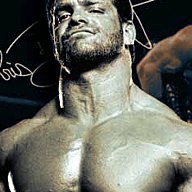|
Think about this: is your favorite wrestler necessarily the best athlete? Or, do they have the best look? Wrestling is first and foremost about character and presentation. Your image and appearance are the first impression you make, so having "The Look" that says you're a wrestler is just as important today as it has always been. |
|
Neck |
   | |
|
When taking back bumps, the biggest precaution you take is tucking your chin into your chest to protect your neck and head. With selling punches and shots to the head, youíll be snapping your head back. Many of the most common moves, like side headlocks and snap mares, also involve a strain being placed on your neck. The majority of wrestlers have a very thick neck for a reason. Train it by laying yourself down on your back on a flat bench, with your head hanging off the end (so that you have to support the weight of it with your neck muscles) and then tuck your chin into your chest slowly, before bringing your head back to the start position slowly. Put a cloth on your forehead and a light plate on top of that and do several reps. Repeat with both sides of your neck. The range of motion for this exercise is only a few inches. | ||
|
Cardio Intensity | ||
|
A lot of the drills at school, and spots in matches involve short bursts of energy as well as the endurance to sustain hard physicality for 5-20 minutes. If you get "blown up" or out of breath, you will get sloppy and weak which can lead to you hurting yourself and others. Practice sprints, and cycling hard. For example: on the treadmill, run for 2 minutes, walk for 3 and repeat for a total of 45 minutes. | ||
|
Strength Training | ||
|
Training for strength in general is a must. Your chest and lower back, in particular, receive a lot of stress during training and therefore require significant attention. Training for strength with every body part would be a good way to get ready. You should be able to easily lift your own bodyweight and have no weak links. If you canít handle your own weight, you probably canít handle someone elseís. | ||
|
Plyometrics | ||
|
Much of what you see in wrestling relies not just on strength but also speed, great balance and agility. You definitely need to be light on your feet. Plyometric training also develops the tendon and ligament strength that prevents or lessens the risk of common wrestling-related injuries. The best way to train is a program consisting of very basic exercises such as standing jumps onto a flat bench (w/feet together), jumping rope etc. | ||
|
The Details | ||
|
Your body has many structural weak links - smaller muscles and joints that only become relatively weaker as you gain strength in larger muscles. Ankles, knees, wrists, elbows, lower back, abdominals, rotator cuff and the groin are the primary areas of injury in all physical activities, not just wrestling. We could list a hundred exercises for these areas, but try to discover some for yourself and incorporate them into your routine now, which will pay dividends and hopefully, keep you as healthy as possible during your career. |